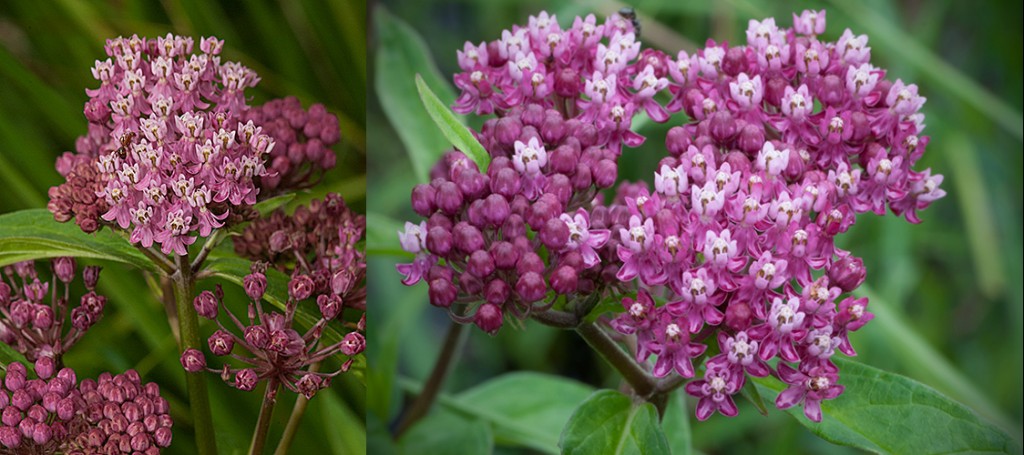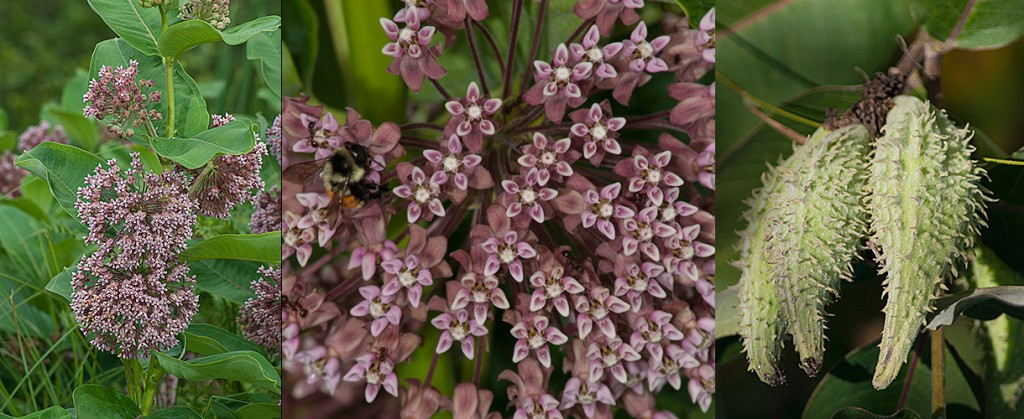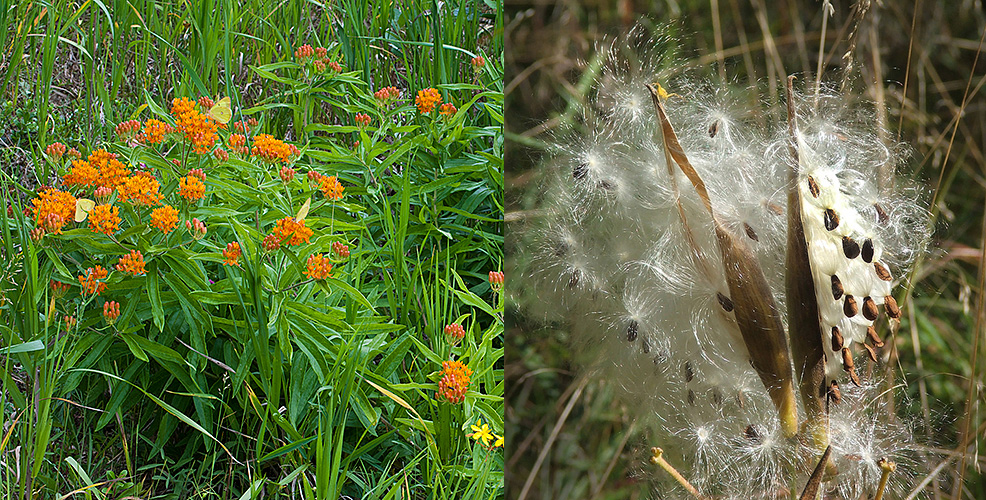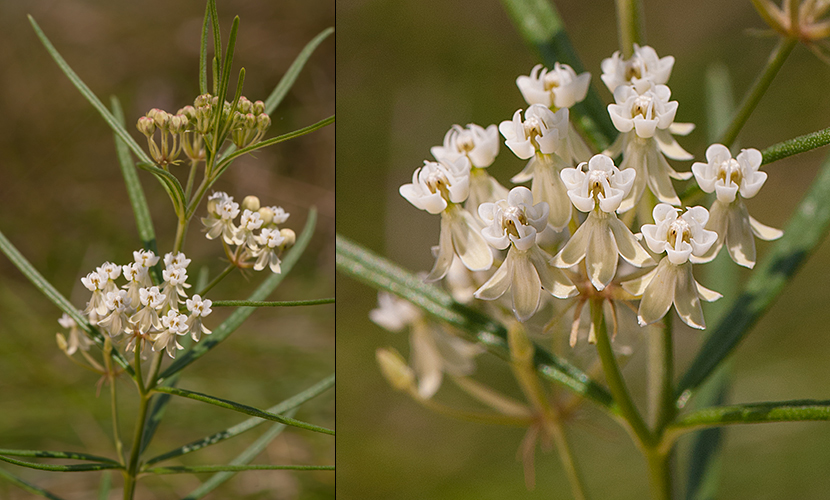Eleven species of milkweeds are native to Michigan. All species except the Butterfly-weed possess milky sap. Monarch butterfly larvae feed on the milkweeds’ foliage and the adults feed on the nectar of the flowers. The pod is correctly called a follicle that is a fruit that splits in half when it is mature along a single joint. Attached to the seed is a feather-like pappus allowing the seed to travel via the wind. Flower clusters are in umbels meaning the individual flower stems all come from the same point. Michigan’s five common species are:
Poke Milkweed (Asclepias exaltata) is a woodland species, having smooth, thin, opposite, leaves that are pointed on each end. Its white flowers, tinted with lavender or green are some of the largest of our milkweeds. Hanging in loose umbels that come from the leaf axils, they are quite distinctive.
Swamp Milkweed (Asclepias incarnata) grows where its feet can get wet. The two-toned (whitish and pink or rose) flowers, in upright clusters, bloom over a long period of time. You can often find plants with follicles that still have flower buds. Smooth, opposite, lanceolate leaves, smooth stem, and narrow upright follicles are good characters to use to recognize this species.
Common Milkweed (Asclepias syriaca) has flowers in dense spherical umbels. Their color varies from white to pink to rose to almost green. The leaves are hairy, opposite and blunt tipped. Warty, fleshy, follicles are covered with fine dense hair. This species is common in fields, woodland edges, and waste places.
Butterfly-weed (Asclepias tuberosa) has non-milky juice, alternate leaves and orange or yellow upright flower. The three photos showing the variation in flower color are all from the same stand. It grows in the Lower Peninsula and is most common in the south half.
Whorled Milkweed (Asclepias verticillata) has narrow leaves in whorls of 3 to 8 and umbels of white flowers that normally appear along the upper third of the plant. This is one of our shortest milkweeds, appearing slender in habit. It grows in dry fields, roadsides, waste places, and prairies; often in large stands, that can be spotted from a moving car. It is more common in southern Michigan but there are several records from the Upper Peninsula.
I would encourage you to plant a few milkweeds in your landscape. Plants are available from many nurseries, the flowers are unique as well as colorful, and the Monarch Butterflies could us the help.
Copyright 2013 by Donald Drife
Webpage Michigan Nature Guy
Follow MichiganNatureGuy on Facebook







I harvest 3 pods for the seeds. I am not finding information on how to store the seeds for the winter. Do I need to keep the fluff attached? I want to plant them in my back yard after the frost clears next year. I am in Michigan.
Please e-mail me with any information you can share.
Thank you,
I would plant the seeds now. I planted Swamp Milkweed last fall and it bloomed this year. I also planted Common Milkweed and the plants grew to about a foot tall this year. Both species had monarch butterfly larva eating them. If you store the seed, you should remove the fluff. Make sure the seed is dry and store it in paper so the seed can breathe. Monarch Watch has some good information on propagating milkweeds. http://www.monarchwatch.org/milkweed/prop.htm Good luck. It’s fun to have milkweed in the yard.
I have one common milkweed plant it’s 70 inches tall and has 14 pods. I live in Grand Rapids Michigan.
Cool!
Is the root of milkweed edible
As far as I know the root is not edible. Given the importance of milkweeds to the survival of the Monarch, I would not recommend digging the plants up for food anyway.
The Michigan Nature Guy
I have many questions that I am not able to find the answers to anywhere unless you can answer them for me.
Do all milkweed have a long taproot? Can they be moved if needed? Are the roots invasive? What is the best ones to grow in a small yard of Royal Oak? Do they feed the caterpillars the first year? Are they a perennial? Do they produce only by seed? Should I fertilize them?
I want to try growing them but want to make sure I can control the plant. For example: the Yucca plant… I can’t get rid of the Damn Thing.
Thanks in advance, Donna S.
http://www.ourhabitatgarden.org/creatures/milkweed-growing.html
http://www.monarchjointventure.org/resources/publications/
These links have information on growing milkweeds. Not all milkweeds have taproots. Swamp milkweed and others do not. Mature plants can be difficult to move. I grow Swamp Milkweed but it has a running root and needs to be controlled. Milkweed can be hard to eradicate once it is established. As my blog noted seeds planted in the fall will produce flowering plants the next year and mine had Monarch larva that first year.
My blog functions mainly as a nature identification blog and not a gardening blog. I am not a Master Gardener. You might wish to join the local Wildones chapter for more growing information. They are the experts on growing native species.
It is August in Michigan. I’d like to know if the seed pods are long gone or if I can gather some of them to plant in the back sunny acre we have. If I can still find seed pods this time of year how would I plant them in the yard? Should I just spread the seeds around as nature would do or would they have a better chance to sprout in the spring by a different way of planting them?
The seed pods on most colonies are just splitting. I try to plant in the fall because the seeds need a cold spell and this is the easiest way to chill them. I remove the fuzzy part and just plant the seeds.
Thanks for all the info on Milkweed Michigan Nature Guy! and for your interesting blog. e.g. I didn’t know that there were 11 types of milkweed in Michigan (I’m just across the river in London Ontario so I’m sure that things here are pretty similar to Michigan). I have Common Milkweed and Butterfly-weed and the pods on both are open now (Nov. 15, 2016) and the seeds are dispersing – maybe they’re late because it’s been such a mild fall? My question about planting the seeds is: how deeply would you plant them? I’m assuming that since in nature they’re dispersed by the wind that they’d germinate on the ground where they land, so pretty close to the surface…?
I remove the coma (fuzzy part) from the seed and barely cover the seed with dirt. Good luck.
we live in the Marquette MI. area. What type of milkweed would be best for Monarchs and where would we get it. Thanks
I would recommend Common Milkweed, but it can be a bit aggressive in the garden. Or Swamp Milkweed. Some nurseries have plants but make sure they are not treated with systemic insecticides. An alternative is to gather a few seeds in the fall and plant them right away. Milkweeds have taproots that make transplanting wild plants difficult.
Is it normal for monarchs to lay her eggs on butterfly weed the small one with the orange flowers. I have five butterfly weed bushes and 12 swamp milkweed. This summer alone from one swamp milkweed bush I counted 14 monarch caterpillars. I realized 3 monarchs yesterday. While I was doing that for the first time a notice a female laying eggs all over the butterfly weed. I thought they only layed eggs on the swamp and common milkweed. Thanks. 🦋😁
Monarchs will feed on any member of the genus Asclepias (any of the Milkweeds).
I’ve had a ton of caterpillars on my swamp milkweed this year – in fact, they completely ate all the leaves, including the flower head! All that’s left is the stem! The leaves are starting to grow back as they are not actively supporting any caterpillars right now. I’m wondering if they’ll get any seed pods this fall since the flower heads are gone right now?
If there’s no remains of the flowers it is doubtful that they can reflower and set seed in a normal season. Sorry.